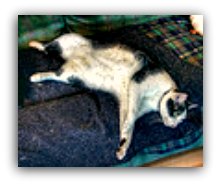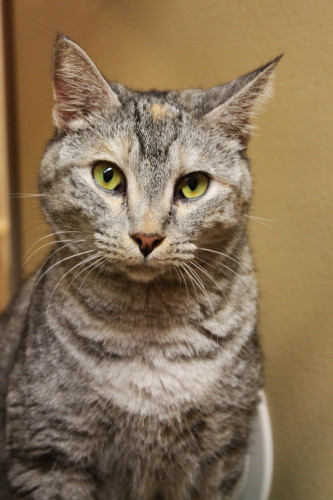What Do You Know About Cat In Heat?

Cat in heat means that the female cat is on her fertile period, which is part of her reproductive cycle. This period is also known as the 'mating period', 'being in season', and 'feline estrus'. During the estrus cycle, the female cat will experience hormonal fluctuations, where she will be receptive to mating.
Is your cat in heat?
Here are some behavioral signs that a female cat will exhibit during the mating period:
** Vocal sounds. The female cat will make strong sounds to attract male cats. These sounds can range from soft, melodious and purring calls to yowling, warbling, caterwauling sounds. Some inexperienced cat owners may mistake these sounds made by their cats with cries of discomfort or pain and rush to the Vet's office.
** If your female cat is an indoor cat, she will try to get outside to gain access to male cat territories. She will pace at the windows and doors of the house, calling the male cat. And, she will make efforts to go outside to seek a male cat in the surrounding area. Be sure to keep your female cat indoors, preventing her from escaping and becoming pregnant.
** Cat in heat will become restless and will be pacing around the house.
** The female cat will rub her head and face against her owner and other surfaces.
** Rolling around on her back and belly.
** Typically the female cat will become more affectionate towards her owner and other pets in the house (pushing her bottom up against them). Although, some female cats can show signs of aggression towards her owner.
** She will also adopt a couched position and hold her tail to the side to expose her female genitalia.
** The female cat will produce a clear discharge and urinate more often. While in heat, the female cat releases pheromones into her urine, which will attract male cats. Instead of urinating all at once, she will make small patches of urine around the house or yard to signal her sexual receptivity to as many male cats as possible.
They may stay in heat from a few days up to 2 weeks, which will depend on variables such as genetics, environment and cat health and age.
How often will she be in heat?
Cats go into heat most often in spring & fall. During this period a female cat will continue to come into heat every 2 to
3 weeks, until she mates.
How can I prevent my cat from coming into heat?
The prevention is quiet simple, have your cat spayed! After the procedure, your female cats will have less desire to roam.
There will be no more signs of cat in heat - heat cycles. Also, the risk of mammary gland tumors, ovarian and uterine cancer will be reduced or eliminated.
It will also help your cat to live longer and healthier.
There are clinics that offer the procedure to cats younger than 5 months, although most veterinarians will recommend to
wait until 4 to 6 months before your cat undergo a general anesthetic procedure, it is much safer for them.
Can a spayed cat come into heat?
The answer to this question should be no. Once the ovaries are removed, the female cat should not produce estrogen, therefore she would not show any signs of cat in heat.
For more information about cat spaying, click here.
Although, there are some cases where a cat who has been spayed will come back into heat weeks to months (even up to 5 years later) after she has been sterilized. When this happens, many cat owners will question whether or not the surgery has been performed correctly.
This may help to answer this question. During the spaying procedure, the veterinarian removed the female cat's ovaries, which will prevent her from getting pregnant. Although, during the procedure the veterinarian did not remove all the ovarian tissues - also called ovarian remnants, which are now cycling and producing estrogen.
This cycling and estrogen production by the ovarian remnant tissue is responsible for the female cat showing the signs of
being in heat. In most cases this will not affect your cat's health and she will not become pregnant, but the cat will
continue to experience signs of heat, and attract male cats into the yard.
In addition to having cycles, spayed cats do very rarely develop a condition called a stump pyometron. This is a serious health condition that may occur in female cats and other female animals, such as dogs, rabbits, ferrets and guinea pigs, that underwent during spaying. In this condition, the remaining uterine stump that has been left behind after the spay surgery becomes infected and filled with a purulent fluid.
The most obvious symptom of such condition is a discharge of pus from the vulva in a female cat that has recently been in
heat. Other symptoms include: vomiting, loss of appetite, depression, and increased drinking and urination.
If your female cat has recently been spayed and you notice any of the symptoms described above, please contact your
veterinarian immediately!
Can my female cat be spayed while she is in heat?
Most vets prefer to spay a cat when she is not actively in heat, due to the higher risks of bleeding complications.
Although the procedure can be performed during this time, ask your veterinarian for his recommendation on this.
My cat just had kittens, when can she be spayed?
Veterinarians will ask to wait about 2 weeks after the
kittens have been weaned. For more information you should contact your
Vet.
Return to Previous Page
Return from Cat In Heat to Our Home Page
Recent Articles
-
Why Maine Coon Cats Love Vertical Space
Jan 05, 25 12:31 PM
Many cat lovers consider Maine coon cats to be the “cool kid on the block”. And who could blame them? Their exotic, wild and feral appearance has awarded -
6 Things Your VET Wants To Tell You
Jan 05, 25 12:27 PM
There is this sort of cultural meme that cats are independent. A lot of us have this idea that the cat is okay as long as the cat is acting okay, but that -
10 Reasons Why You Shouldn't Let Your Cat Roaming Outside Unsupervised
Jan 05, 25 12:20 PM
As a mindful cat owner, the decision of either letting them roam outside or keeping them indoors as an inside only cat is daunting. Some people argue
Healthy Cat Treat

Subscribe to Our Love Cats Digest e-zine
"A cat improves the garden wall in sunshine, and the hearth in foul weather." - Judith Merkle Riley
Marketing Strategies by













New! Comments
Have your say about what you just read! Leave me a comment in the box below.